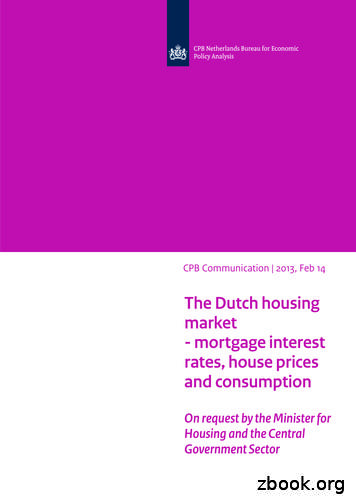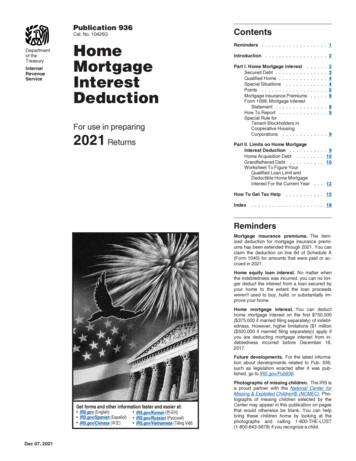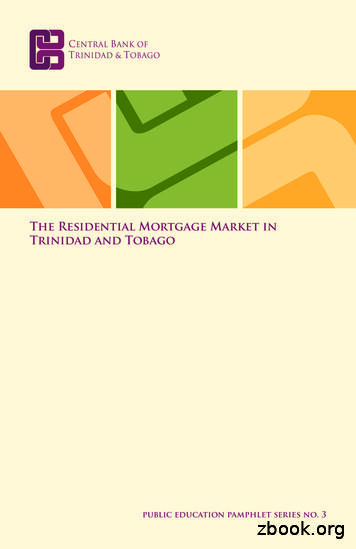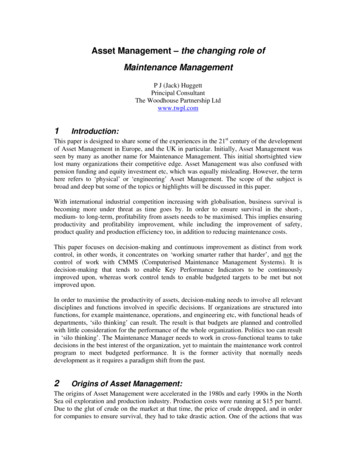Interest Rates And Mortgage Borrowing Power In Canada
FRASERRESEARCHBULLETINAugust 2017Interest Rates andMortgage Borrowing Power in Canadaby Josef Filipowicz, Jason Clemens, and Matthew LauSummary One often-overlooked contributing factorto rising home prices in Canada is mortgageinterest rates. Between 2000 and 2016, the prevailingmortgage interest rate declined from 7.0 percent to 2.7 percent. This decline resulted in a52.9 percent increase in the mortgage borrowing power (maximum eligible mortgage size) ofpotential home buyers. Based on average family incomes in 2000,falling interest rates resulted in increasedmortgage borrowing power in the four mainregions over the same period: Vancouver from 183,751 to 280,893; Calgary from 221,214 to 352,671; Toronto from 221,214 to 338,161; andMontreal from 171,692 to 262,459.fraserinstitute.org Average family incomes also increased from2000 to 2014. Specifically, average nominalbefore-tax family income for Canada as a wholeincreased 53.0 percent over this period withchanges in the four metropolitan areas as follows: Vancouver incomes increased by 47.8 percent; Calgary by 76.8 percent; Toronto by 35.2percent; and Montreal by 45.5 percent. Rising average family income coupled withdecreasing interest rates resulted in a pronounced increase in the ability of potentialhome buyers to borrow. Specifically, the increase in nominal mortgage borrowing powerfor Canada as a whole was 126.1 percent. The four metropolitan areas ranged from ahigh of 161.2 percent in Calgary to a low of 99.7percent in Toronto with both Vancouver andMontreal recording similar increases of 118.4percent and 115.0 percent, respectively.FRASER RESEARCH BULLETIN 1
Interest Rates and Mortgage Borrowing Power in CanadaIntroductionRising home prices in Canada have spurred interest in the potential causes and consequences of the increases. Like most goods, housingprices reflect the complex interaction of supply and demand and are driven by the innumerable motivations of buyers and sellers. Formany buyers, the purchase of a home is thesingle largest investment they ever make, and istypically funded through a combination of savings (for a down payment) and borrowing, normally through a mortgage loan. The size of themortgage for which borrowers can ultimatelyqualify depends on a number of factors including income, other debts, and the interest rate atwhich they can borrow.This research bulletin explores how one ofthese factors, interest rates, influences mortgage borrowing power (ie., maximum eligiblemortgage size), and therefore housing demandin Canada. The rates at which individuals andfamilies can borrow are historically low,1 meaning that larger loans and/or less expensive interest costs are available to them now morethan at any other time in recent decades. Giventhe powerful effect interest rates have on theamount of borrowing individuals and familiescan undertake it is particularly surprising howlittle public attention this aspect of housingprices has received in recent years.The approach used in this study is neither a definitive nor an overly complex analysis of theinteraction between interest rates and mortgage borrowing power. Rather, it is a simpleoverview aiming to raise awareness on themanner in which lower interest rates increasethe amount of borrowing individuals and families can secure. The resulting boost in mortgageborrowing power likely plays a role in risinghome prices observed across much of Canada.The link between interest rates,borrowing, and home pricesBefore analyzing the link between interest ratesand the ability to borrow, it is important to understand the general concept and its effect onhome prices. The primary goal of lenders is tohave borrowers return their capital plus theinterest charged on loans. This is the principlebehind the guidelines that lenders use to determine how much money they are willing to lend aborrower based on his or her income and assets.A decline in interest rates reduces the amountborrowers must dedicate to interest payments,creating more room for them to repay the principal amount they owe. This in turn gives borrowers greater capacity to borrow with thesame amount of income.The increased capacity to borrow means thatlarger mortgages become available to homebuyers, which has an important impact onhousing markets. Without any increase in income or repayment requirements, potentialhome buyers can afford to borrow more money,enabling them to bid up the price of an underlying asset—in this case, housing.2The simple analysis that follows assumes thatthe supply of housing is not immediately responsive to changes in demand. This is reasonable given the time it takes for home buildersto assemble land, acquire permits and approvals, secure necessary resources, and actuallybuild homes. The degree to which housing supply is responsive to changes in housing demand21For more on the potential causes of low interestrates, see Walker (2016).fraserinstitute.orgFor more on the way interest rates and liquidityconstraints affect consumer behaviour, see Grossand Souleles (2002).FRASER RESEARCH BULLETIN 2
Interest Rates and Mortgage Borrowing Power in CanadaFigure 1: Estimated Mortgage Borrowing Power with Average Canadian FamilyIncome, 2000 (at 2000 – 2016 interest rates)8% 276,6107.0%7% 290,000 270,0006% 250,0005% 230,0004%2.7%3% 190,0002%1% 210,000 180,949Average discounted mortgage interest rate 170,000Maximum mortgage size - Canada*0% 150,0002000 2001 2002 2003 2004 2005 2006 2007 2008 2009 2010 2011 2012 2013 2014 2015 2016* Based on the Canadian average income of 50,785.Source: Statistics Canada, 2017a and 2017b; Mortgage Professionals Canada; calculations by authors.could partially mitigate the bidding up of housing prices.3The effect of lower interest rates onmortgage borrowing powerTo estimate how interest rates influence mortgage borrowing power, we used a standardmortgage qualification calculation at the prevailing market interest rates (see Appendix 1 fordetails on the data, formula, and assumptionsused) for a standard fixed-rate mortgage.4 Theanalysis uses the average Canadian family in-come5 in 2000 of 50,785. This calculation estimates the maximum amount of lending available to a family earning the national averageincome in 2000 at different interest rates.6Figure 1 shows both the prevailing interest rate7for each year and the maximum amount of eli5Average incomes presented in this study are calculated using CANSIM Table 111-0014: Family Characteristics, by Family Type and Sources of Income,Annual, by dividing “Amount of income” by “Numberin family type.” For Statistics Canada’s definition ofCensus families, see ref/dict/fam004-eng.cfm.6For an in-depth analysis of housing supply responsiveness in Canada, see Green, Filipowicz, Lafleur,and Herzog (2016).This approach follows the preliminary mortgagepayment estimates that many lending institutionsoffer (see Appendix 1), not the specific methods ultimately used in final mortgage agreements.473We assume a monthly payment frequency over a25-year amortization period (see Appendix 1).fraserinstitute.orgTo build our average annual interest rate estimates,we used chartered bank five-year conventional mort-FRASER RESEARCH BULLETIN 3
Interest Rates and Mortgage Borrowing Power in CanadaFigure 2: Estimated Mortgage Borrowing Power in Major Metropolitan Areas Basedon 2000 Average IncomesMaximum mortgage size - Metro Vancouver* 350,000Maximum mortgage size - Greater Calgary**Maximum mortgage size - Greater Toronto*** 338,161Maximum mortgage size - Greater Montreal**** 300,000 250,000 352,671 280,893 230,706 262,459 221,214 200,000 183,751 171,692 150,0002000 2001 2002 2003 2004 2005 2006 2007 2008 2009 2010 2011 2012 2013 2014 2015 2016* Based on the Metro Vancouver average income of 51,572; ** Based on the Greater Calgary average income of 64,750;***Based on the Greater Toronto average income of 62,086; ****Based on the Greater Montreal average income of 48,187.Source: Statistics Canada, 2017a; Mortgage Professionals Canada; Statistics Canada, 2017b; calculations by authors.gible mortgage a family could secure based ona static income of 50,785.8 As the figure illustrates, the prevailing interest rate fell from 7.0gage rates, obtained from Statistics Canada. As theseare official posted rates, they do not reflect typicalrates at which Canadians can ultimately borrow forhome loans. As such, we obtained the average spreadbetween posted rates and real rates from annualsurveys published by Mortgage Professionals Canada(formerly the Canadian Association of AccreditedMortgage Professionals) between 2005 and 2016. For2000 to 2004, we applied the 2005 spread retroactively. Though less accurate, this approach is conservative, as spreads between posted interest rates andreal interest rates grew considerably over that period(Allen, Clark, and Houde, 2011).8Average incomes are not necessarily representative of the typical home buyer. Home owners repre-fraserinstitute.orgpercent in 2000 to 2.7 percent in 2016, a declineof 61.3 percent.When interest rates fall, the same individual orfamily with the same income ( 50,785) can borrow more money. Specifically, the maximumamount this family could borrow increasedfrom 180,949 based on prevailing rates in2000, to 276,610 at 2016 rates, an increase of52.9 percent. It is important to remember thatthe resulting estimates represent maximummortgage loan eligibility, not home prices.Figure 2 moves beyond the hypothetical nationalanalysis and specifically examines Canada’s fourlargest metropolitan areas: Vancouver (Britishsent just over two-thirds of Canadian households in2011 (National Household Survey, 2011).FRASER RESEARCH BULLETIN 4
Interest Rates and Mortgage Borrowing Power in CanadaTable 1: Growth in Family Income byMajor Metropolitan Centre (2000 - 2014)Vancouver47.8% (17.8% in real terms)Calgary76.8% (25.4% in real terms)Toronto35.2% (1.6% in real terms)Montreal45.5% (13.0% in real terms)Canada53.0% (18.5% in real terms)Source: Statistics Canada, 2017b and 2017c.Columbia), Calgary (Alberta), Toronto (Ontario),and Montreal (Quebec). The analysis from figure1 is replicated for figure 2; the difference is thataverage incomes are regional.In 2000, the average gross family income9 inVancouver, Calgary, Toronto, and Montreal could have supported borrowing of up to 183,751, 230,706, 221,214, and 171,692, respectively, given the prevailing interest rate formortgages that year (7.0 percent). The variationin the mortgage amounts is driven entirely bythe differences in average family income between the four cities in 2000: 51,572 in Vancouver, 64,750 in Calgary, 62,086 in Toronto,and 48,187 in Montreal.If the income levels are kept constant, but interest rates are allowed to drop from 7.0 percent, where they were in 2000, to 2.7 percent,where they were in 2016, potential home buyerssee a marked increase in their ability to borrow.Specifically, the same level of average incomein Vancouver, for instance ( 51,572), could support borrowing of up to 280,893 in 2016, an9Gross debt service (GDS) ratios are calculatedbased on gross income (See Appendix 1). As such,this analysis does not account for after-tax income.fraserinstitute.orgincrease of almost 53 percent. The three othermetropolitan areas see the same proportionateincreases: Calgary rises to 352,671, Toronto to 338,161, and Montreal increases to 262,459.How rising incomes amplify the effect oflower interest ratesThe previous section examined the effect ofinterest rates on mortgage borrowing powerwhen income remained constant. This section adjusts average incomes to reflect the factthat between 2000 and 2014, the latest year ofavailable data, average family incomes in thekey metropolitan areas examined increased. Indeed, average total incomes for Canadian families as a whole grew by 53 percent in nominalterms between 2000 and 2014 (18.5 percent inreal terms).Table 1 shows the growth in average family incomes in the four metropolitan areas analyzedbetween 2000 and 2014. Figure 3 depicts thegrowth in the maximum mortgage borrowingpower by major metropolitan region between2000 and 2014 based on both the change in average family income and the falling interest rate(from 7.0 percent to 3.0 percent).Once the calculations allow for rising incomes,it is clear that the maximum mortgage borrowing power increases beyond the 52.9 percent observed when only the decline in interestrates was accounted for. Calgary experiencedthe largest increase in mortgage borrowingpower between 2000 and 2014 (rising 161.2 percent). The Greater Toronto Area experiencedthe smallest increase in mortgage borrowing power (though still showed a marked increase of 99.7 percent). Mortgage borrowingpower increased by 118.4 percent in Vancouver and by only slightly less in Montreal (115.0percent). Across Canada, mortgage borrow-FRASER RESEARCH BULLETIN 5
Interest Rates and Mortgage Borrowing Power in CanadaFigure 3: Estimated Mortgage Borrowing Power in Major Metropolitan Areas,Including Income Growth (2000-2014) 700,000Maximum mortgage size - Metro Vancouver* 602,700Maximum mortgage size - Greater Calgary** 600,000Maximum mortgage size - Greater Toronto***Maximum mortgage size - Greater Montreal**** 500,000 441,846 401,395 400,000 369,188 221,214 300,000 230,706 200,000 171,692 100,000 183,751 01220132014Source: Statistics Canada, 2017a; Mortgage Professionals Canada; Statistics Canada, 2017b; calculations by authors.ing power rose by 126.1 percent. Put differently,the growth in average family income coupledwith the decline in prevailing interest rates formortgages increased Canadians’ ability to borrow for mortgages by 126.1 percent, more thandoubling the nominal amount they could borrow in 2000.ConclusionHistorically low interest rates present a numberof opportunities for potential home buyers. Ifthey can borrow at lower interest rates, a smaller portion of their mortgage payments is dedicated to interest and a larger portion to principal loan repayment. These savings qualify buyersfor larger loans, or they can be channeled toother household priorities. However, increasedborrowing power also affects home prices.The decline in mortgage interest rates between2000 and 2016 was estimated to result in a 52.9fraserinstitute.orgpercent increase in mortgage borrowing power.This effect is amplified when increases in family incomes are taken into account. Specifically,the increase in average family incomes coupledwith the noted decline in interest rates resulted in a marked increase in mortgage borrowingpower across all four metropolitan areas analyzed: Vancouver (118.4%), Calgary (161.2%), Toronto (99.7%) and Montreal (115.0%). For Canada as a whole, the combination of the increasein average family incomes plus the decline ininterest rates resulted in an increase in mortgage borrowing power of 126.1 percent.Housing prices reflect the interaction of supply and demand, and the significant increase inmortgage borrowing power attributable to lower interest rates plays a role in this interaction.As such, the extent to which increased mortgage borrowing power influences home pricesdeserves closer consideration by Canadiansand their policy makers.FRASER RESEARCH BULLETIN 6
Interest Rates and Mortgage Borrowing Power in CanadaAppendix 1: Mortgage CalculationTo produce the estimates in this study, we used the Canada Mortgage and Housing Corporation’smonthly mortgage payment calculation (CMHC, 2017a) with the following formula and assumptions:FormulaMonthlynumber of payments 11 monthly interest ratepayment xnumber of paymentsmonthly interest rate x 1 monthly interest rateAssumptions»»Monthly payment frequency»»25-year amortization period»»Fixed interest rate throughout duration of loan*Maximum monthly payment estimatesMaximum monthly payments were calculated using the gross debt service (GDS) ratio, a commonlyused tool in mortgage lending. Lenders use this ratio as an initial threshold whereby the amount ofdebt a potential borrower desires is compared to their income to ensure that the repayment schedule is sustainable. This approach, formulated below, adds the monthly payments required by themortgage loan (principal plus interest), plus property taxes and heating.** In order to qualify for amortgage, an applicant’s GDS ratio must typically be 35 percent*** or lower (CMHC, 2017b), whichmeans that a borrower’s home-related and mortgage servicing costs**** cannot exceed 35 percent oftheir total annual income. It is a method that lenders use to ensure borrowers only accumulate debtwithin reasonable and serviceable constraints.GDS calculationPrincipal Interest Taxes HeatGross Annual IncomeFor the purposes of this study, monthly payments on property taxes and heating were estimated at5 percent of gross monthly income. This approach does not account for variation across municipalities, regions, and housing types. *Holding the interest rate fixed throughout the duration of the loan is a conservative approach, as rates are often revised down at theend of each mortgage term.**Where applicable, 50 percent of monthly condominium fees are also included.***Some lenders use a GDS ratio of 32 percent.****Lenders also use the total debt service (TDS) ratio to incorporate other household expenses. Green, Jackson, Herzog and Palacios (2016) estimate that energy spending represents 2.6 percent of total household spending acrossCanada in 2013, and Chawla and Wannell (2003) estimate that property taxes represented 1.8 percent of income for Canadian familiesearning 100,000 and above. Without property-specific information on non-mortgage housing costs, different authors use different assumptions to produce broadcomparisons. Masson (2013) assumes annual non-mortgage housing costs are equal to 5 percent of the mortgage amount.
Interest Rates and Mortgage Borrowing Power in CanadaAppendix 2: Increases in mortgageborrowing powerFigure A2.1 gives some additional context. Itshows increases in mortgage borrowing powerbased on average monthly mortgage paymentsin four metropolitan areas in 2016. The CanadaMortgage and Housing Corporation (CMHC)provided these averages.This figure clearly indicates the difference inmortgage borrowing behavior across the various regions. For example, Metro Vancouveritesmake the largest monthly payments of the fourregions, even though they earn less than Torontonians and Calgarians, on average.Figure A2.1: Estimated Mortgage Borrowing Power in Major Metropolitan Areas, byAverage Monthly Mortgage Payment in 2016 450,000Maximum mortgage size - Metro Vancouver*Maximum mortgage size - Greater Calgary** 437,848Maximum mortgage size - Greater Toronto*** 400,000Maximum mortgage size - Greater Montreal**** 382,313 350,000 333,959 300,000 286,425 200,000 238,232 250,096 250,000 218,464 155,843 0201120122013201420152016* Based on the Metro Vancouver average of 2,010 monthly; ** Based on the Greater Calgary average of 1,533 monthly;***Based on the Greater Toronto average of 1,755 monthly; ****Based on the Greater Montreal average of 1,093 monthly.Source: Statistics Canada, 2017a; Mortgage Professionals Canada; CMHC, 2017c; calculations by authors.fraserinstitute.orgFRASER RESEARCH BULLETIN 8
Interest Rates and Mortgage Borrowing Power in CanadaReferencesAllen, Jason, Robert Clark, and Jean-François Houde(2011). Discounting in Mortgage Markets. Working Paper 2011-3. Bank of Canada. /02/wp11-3.pdf , as of July 19, 2017.Canada Mortgage and Housing Corporation [CMHC](2017a). Mortgage Payment Calculator. On-line calculator. CMHC. https://www.cmhc-schl.gc.ca/en/co/buho/buho 021.cfm , as of July 19, 2017.Canada Mortgage and Housing Corporation [CMHC](2017b). Calculating GDS/TDS. On-line calculator.CMHC. opr/mupr 015.cfm , as of July19, 2017.Canada Mortgage and Housing Corporation [CMHC](2017c). Average Scheduled Monthly Payments forNew Mortgage Loans ( ), Canada, Provinces andCMAs 2012 Q3 to 2016 Q4. Homeowners’ Debt at aGlance Data Tables. Web page. tda/data/data 018.cfm , as of July 19, 2017.Chawla, Raj K. (2017). The distribution of mortgage debt in Canada. Statistics Canada. cle/11429-eng.htm Chawla, Raj K., and Ted Wannell (2003). PropertyTaxes. Perspectives on Labour and Income 4, 7.Statistics Canada. ng.html , as of July19, 2017.Green, Kenneth P., Josef Filipowicz, Steve Lafleur,and Ian Herzog (2016). The Impact of Land-UseRegulation on Housing Supply in Canada. FraserInstitute. n-canada.pdf , as of July 19, 2017.Green, Kenneth P., Taylor Jackson, Ian Herzog, andMilagros Palacios (2016). Energy Costs and Canadian Households: How Much Are We Spending?Fraser Institute. s/energy-costs-and-canadian-households.pdf , as of July 19, 2017.fraserinstitute.orgGross, David B., and Nicholas Souleles (2002). Do Liquidity Constraints and Interest Rates Matter forConsumer Behavior? Evidence from Credit CardData. Quarterly Journal of Economics 117, 1: 149–185.Masson, Paul R. (2013). The Dangers of an Extended Period of Low Interest Rates: Why the Bankof Canada Should Start Raising Them Now. CDHowe Commentary No. 381. CD Howe Institute. ents/research papers/mixed/Commentary 381 0.pdf , as of July 19, 2017.Mortgage Professionals Canada (various years,2006–2016). Annual State of the Residential Mortgage Market in Canada. Ratehub.ca. https://www.ratehub.ca/canadian-mortgage-reports , asof July 19, 2017.Statistics Canada (2013). National Household Survey (NHS) Profile: Canada. 2011 National HouseholdSurvey. Catalogue no. 99-004-XWE. Governmentof Canada. details/page.cfm?Lang E&Geo1 PR&Code1 01&Data Count&SearchText Canada&SearchType Begins&SearchPR 01&A1 All&B1 All&Custom &TABID 1 , as of July 19, 2017.Statistics Canada (2017a). Table 176-0043: Financial Market Statistics, Last Wednesday Unless Otherwise Stated, Bank of Canada. Government ofCanada. http://www5.statcan.gc.ca/cansim/a26?id 1760043 , as of July 5, 2017.Statistics Canada (2017b). Table 111-0014: Characteristics of Families, Sources of Income by Census FamilyType. Government of Canada. http://www5.statcan.gc.ca/cansim/a26?lang eng&id 1110014 , asof July 31, 2017.Statistics Canada (2017c). Table 326-0020: ConsumerPrice Index (CPI) Monthly (2002 100). Government of Canada. http://www5.statcan.gc.ca/cansim/a26?id 3260020 , as of July 19, 2017.Walker, Michael (2016). Why Are Interest Rates SoLow? A Framework for Modeling Current Global Financial Developments. Fraser Institute. s/whyare-interest-rates-so-low.pdf , as of July 19, 2017.FRASER RESEARCH BULLETIN 9
Interest Rates and Mortgage Borrowing Power in CanadaJosef Filipowicz is a Senior PolicyAnalyst in the Centre for MunicipalStudies at the Fraser Institute. Heholds an M.A. in Political Sciencefrom Wilfrid Laurier University,and a Bachelor of Urban and Regional Planning from Ryerson University. His work with the FraserInstitute includes the New Homesand Red Tape series focusing on theregulatory landscape surroundinghome-building in Canada’s municipalities, as well as analysis ofthe impact land-use regulation hason the housing supply in Canada’slargest cities.Jason Clemens is the Executive VicePresident of the Fraser Institute. Hehas an Honors Bachelors Degree ofCommerce and a Master’s Degree inBusiness Administration from theUniversity of Windsor as well as aPost Baccalaureate Degree in Economics from Simon Fraser University. He has published over 70 majorstudies on a wide range of topics,including taxation and entrepreneurship. He has published over 300shorter articles in US, Canadian,and international newspapers.Copyright 2017 by the Fraser Institute. All rights reserved. Without written permission, only brief passages may be quoted in critical articles and reviews.ISSN 2291-8620Media queries: For media enquiries, please contactour communications department via e-mail: communications@fraserinstitute.org; telephone: 604.714.4582.Support the Institute: call 1.800.665.3558, ext. 574or e-mail: development@fraserinstitute.orgVisit our website: www.fraserinstitute.orgAcknowledgmentsThe authors wish to thank the anonymousreviewers for their comments and suggestions on this paper.As the researchers have worked indepen dently, the views and conclusions expressedin this paper do not necessarily reflectthose of the Board of Directors of the FraserInstitute, the staff, or supporters.Matthew Lau was a research internwith the Fraser Institute in 2016.He holds a Bachelor of Commercewith a specialization in finance andeconomics from the University ofToronto.fraserinstitute.orgFRASER RESEARCH BULLETIN 10
to rising home prices in Canada is mortgage interest rates. Between 2000 and 2016, the prevailing mortgage interest rate declined from 7.0 per-cent to 2.7 percent. This decline resulted in a 52.9 percent increase in the mortgage borrow-ing power (maximum eligible mortgage size) of potential home buyers. Based on average family incomes in 2000,
The main types of mortgage interest rates are fixed and variable interest rates. According to World Bank, in higher and more volatile inflation environments, fixed-rate mortgages become either prohibitively expensive or too risky for lenders to offer. According to Njongoro (2013), mortgage interest rates reflect the general lending rate
with fixed-term interest rate periods of more than 1 year. On average, mortgage interest rates in the Netherlands are 1 percentage point above the EU average. The central question is what would explain the high Dutch mortgage interest rates. The mortgage interest rate that banks charge their customers depends on the bank's marginal
A fixed-rate mortgage (FRM) is a mortgage in which the rate of interest charged remains unchanged throughout the entire term of the loan. iv. A variable-rate mortgage (VRM) is a mortgage in which the rate of interest charged is subject to change during the term of the loan. v. An adjustable-rate mortgage (ARM) is a mortgage in which the
home mortgage interest. It includes discussions on points, mortgage insurance premiums, and how to report deductible interest on your tax re-turn. Generally, home mortgage interest is any in-terest you pay on a loan secured by your home (main home or a second home). The loan may be a mortgage
Updated: 21 June 2021. 2-1 Part 2 - Mortgage (National Mortgage Form) General Law Mortgage [2-0000] A lot or an interest may be mortgaged by registering a mortgage for the lot or interest (s. 72(1)
Our end to end mortgage supporting services improved quality of reviews and mortgage loan purchase time of clie\ nt. Keywords: mortgage back-office support services; mortgage processing support services; outsource mortgage processing services Created Date: 4/12/2018 4:17:49 PM
The mortgage term or amortization period is the actual number of years that it will take to repay the entire mortgage loan. The total cost of the mortgage is the sum of interest payments plus the amount of the loan. This cost is impacted by the mortgage term and the interest rate. For a given interest rate, the longer the
Asset Management has now spread to many utility organizations and large and small companies are adopting similar programs. 3 The changing role of Maintenance Management in Asset Management: To illustrate how maintenance managers can contribute to an Asset Management improvement program, the table below lists some common issues facing management in the first column, and thoughts on how these .























